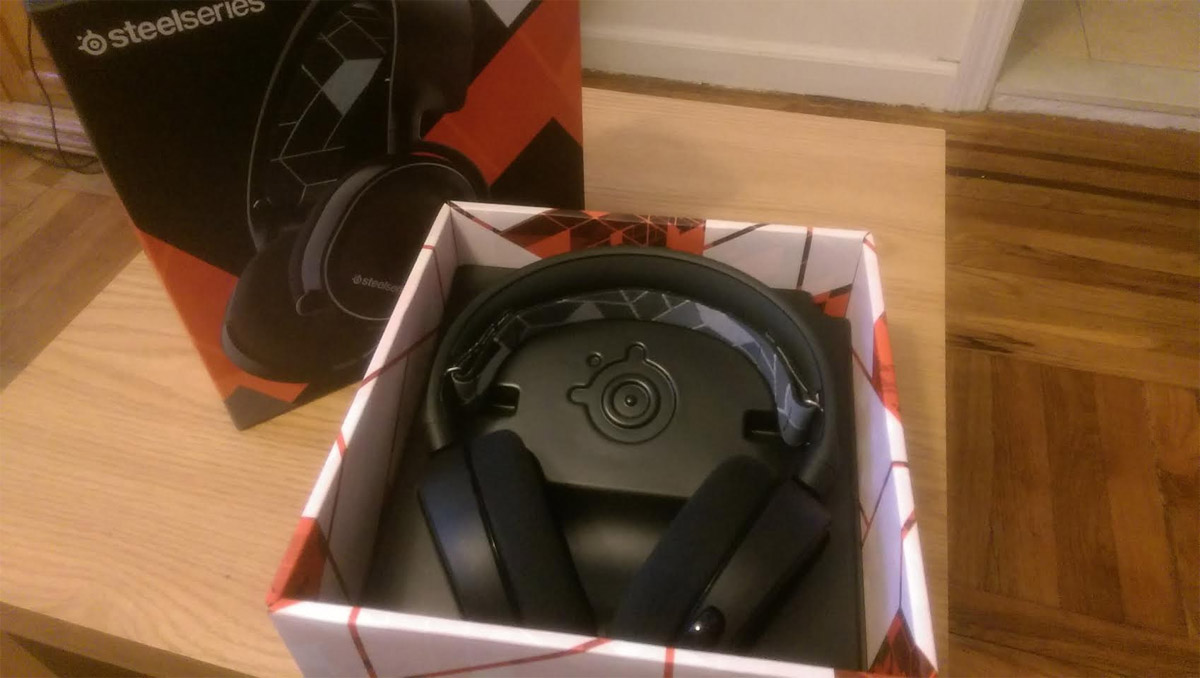

Steelseries is a big name in headsets, so when they told me they were launching a radically different line, I was intrigued. After using the Arctis 3 in my daily work and gaming routine for over three weeks, I’ve been impressed with the performance, though the experience comes with its own unique, and sometimes annoying, quirks.
The Arctis line from Steelseries, a new line of headsets designed from the ground up to refocus on minimalist yet gamer-driven emphasis, launched this fall. While the Arctis 3, Arctis 5, and Arctis 7 have increasingly specialized features, each one is designed to boast the same quality sound. The unit I received was an Arctis 3, the set with the most basic features and lowest price tag of the three. Despite being the least expensive, this price-point ($80) still puts the unit on the high end of mid-cost units. The Arctis 3 comes with the headset and three separate cords. There’s a universal cord which plugs into the headphones and can then plug into a variety of audio out adapters, two of which come with the headset: a short 4-pole adapter (which can plug into controllers, phones, etc.) and a long 3.5 mm analog adapter that can plug into the audio and mic ports of a PC. Compare this with the Arctis 5 ($100 with USB connection and RGB LEDs) and Actis 7 ($150 for USB connection and wireless option).

Regarding the physical construction, the Arctis 3 has a unique suspension band (made of the same material found in ski goggles) that sits an inch under the hard plastic band connecting the two earphones. It’s fully adjustable via velcro on both ends and Steelseries even offers additional bands for sale if you want to make the headset a style statement. Functionally, the stretchy band ensures the unit won’t slip off your head and is more comfortable than any headset I’ve previously owned. It beats padding any day of the week. I was similarly impressed with the comfort of the memory foam earpads. They fully enclose the ear without squeezing too tightly or slipping out of place.
Continuing on with the features, the Arctis 3 has a button and a dial on the back of the left earcup. The button is for muting the mic (it’s flush with the earcup when unmuted, raised when muted) and the dial is for volume control. I like the idea of the volume being directly located on the earcup, though I did notice I inadvertently spun it a few times when picking up or putting down the headset. This led to some confusion as to why my sound had cut out when I came back to my computer. This is by no means a deal-breaker, but one of those potential quirks you might want to be aware of.
The mic is also located on the left earcup and is fully retractable into the cup (it curves along the inside). The wire is bendable so you can position the mic at your preferred distance from your face. Though I generally prefer microphones that have a rigid arm that swings up and down, no major complaints about this retractable one aside from having to adjust it whenever I use it due to how the wire naturally bends when fully retracted. After doing that, though, it won’t move around from the position I’ve set it to while in use. The microphone itself is bidirectional, with the intent to reduce background sound as much as possible. The quality of the mic is very clear for voice chat, but it still seemed to pick up a fair amount of background sound. When snapping a good arms-length away from the headset, the microphone still caught it.
The biggest issue I had with the Actis 3, however, didn’t have anything to do with the physical hardware; it was an issue I had with the software. In order to access the full audio features on PC (such as surround sound and sound mixer) you have to make a Steelseries account, download the Steelseries Engine, and link your specific unit to your account with a key that comes in the box. Maybe I’m behind on the times, but I’ve never had to input a key for a gaming peripheral in order to fully utilize the settings on the device. This also isn’t just a factor of inconvenience; if there’s some kind of issue with the attached device being recognized by the Steelseries Engine (a problem I had), then these features end up being locked until the problem gets resolved. Not to mention the whole affair makes it a little awkward to give the headset to a friend or family member sometime down the road.
As a complete package, the Arctis 3 is sleek and as stylish as a headset will ever be. It’s extremely comfortable to wear for extended periods of time and the microphone provides clear voice communication, if not providing as much background sound elimination as I hoped. The gated sound features (and all the problems that can occur with an account-bound physical product) as well as other previously mentioned minor complaints (e.g. adjustable mic, potential for accidental adjustment of volume) prevent me from giving this headset a perfect rating; however, even with these flaws, the Arctis 3 is an extremely strong contender in the headset market. It’s certainly the most comfortable headset I’ve owned and it will get a lot of future use.
An Arctis 3 headset was provided to us by Steelseries for review.